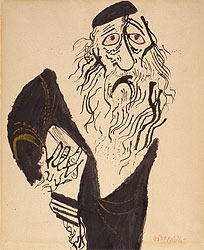FOCUS IN/ON - William Gropper
Gropper's Artistic Approach, Style, and Influences

William Gropper, 1897-1977 The Wanderer, c. 1960 Ink with wash on paper, 16" x 14" Hillstrom Museum of Art, gift of Reverend Richard L. Hillstrom ('38)
The style of Gropper's work is generally characterized by an immediacy and a graphic strength that comes from his experience as a cartoonist. Gropper's art is never merely propaganda without aesthetic concern, but it is art first, with its social message made all the more effective for it being tied to artistically successful imagery. Art critic Ralph M. Pearson, in a 1940 article in Forum magazine, noted, "the most weighty reason for Gropper's importance is that he does not forget art when he is an avenger or prophet. His propaganda is always art; his art is sometimes propaganda."
Gropper was influenced by many different artists and styles for both his general and specific artistic approach. He was sometimes called the Daumier of his day, after the great French political cartoonist Honoré Daumier (1808-1879), who shared with Gropper not only an incisive ability in draftsmanship but also a probing interest in the oddities and stupidities of humans, especially those in power. Gropper was also heavily influenced by the Spanish artist Francisco de Goya y Lucientes (1746-1828), and a number of connections to works by Goya can be found, including Gropper's 1940 oil painting titled Firing Squad that relates closely to Goya's famous 1813 image of Napoleonic forces haphazardly slaughtering Spaniards, The Third of May, 1808. Gropper also drew from Goya in a series of prints dating from 1953 to 1956 in which he commented upon the idiocy that gripped the nation during the McCarthy era. Gropper was blacklisted when he refused to cooperate with Senator McCarthy's committee when it investigated his images of American folklore figures such as Paul Bunyan (which were deemed somehow subversive). Gropper titled his prints relating to this experience the Caprichos, borrowing the title of Goya's 1799 etchings, which exposed the follies of late eighteenth century Spanish society.
Two other of the widely varied artistic influences on Gropper are Asian art and Cubism. Some of this influence can be seen in the Hillstrom ink and wash drawing, which likely dates to 1960, since it was purchased by Reverend Hillstrom not long after and since there is another, larger drawing of the same name from that year (published in an exhibition catalogue a few years later). The loose, dotted, energetic and calligraphic handling of the ink in the Hillstrom work connects it to Japanese and Chinese ink painting, and also further supports the 1960 dating, since this handling is very similar to a published drawing from that year. The disjointed quality of the form of the old man in The Wanderer is found with some frequency in Gropper's work, an influence of the fracturing effect in Cubist art.
The Wanderer is a powerful image that immediately grabs the viewer's attention. Gropper reddened the figure's eyes, reserving this intense color for only that purpose and for his signature in the lower right of the drawing. The forlorn state of the man is thereby emphasized and his status as a "wanderer" is indicated (the reference is both to the antisemitic legend that Christ condemned a Jewish figure to restlessly wander the earth for being disrespectful on the way to the Crucifixion, and, more importantly, to the dispossessed status of Jews since the conquests against the ancient Jewish kingdoms). The plight of the Jews is depicted in the man's body language, including the arthritic contortion of his hand and the disjointed form of his torso, as well as in his facial expression. Both the subject and the intensity of the drawing associate it with several works Gropper made in response to his visit to the Jewish Ghetto in Warsaw after World War II in 1948.